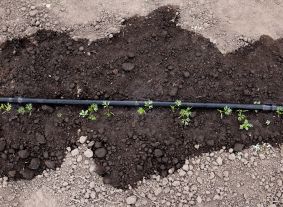Winter Rye for the Home Garden
Views: 8790
Planting winter rye is something that I am familiar with from my experiences as a child. Growing up on a 500-acre farm, sowing rye seeds in the fall was something my dad did after the fall harvests, once the fields were cleared. Quite honestly, I thought he did it to appease my mom. The foot-tall rye crop would help hold the soil down during the winter winds. If the rye didn’t get planted, my mom would have a continuous job of “dusting” the fine soil that would filter through the windows and settle over everything. God have mercy on my dad if he got the rye planted late!
As I got older I understood that this last crop of the year had other, if not greater, purposes. (What’s greater than appeasing my mom and keeping the dust away?). But not until this year did I consider these purposes for my own garden plot. Here are some of the benefits of planting winter rye in the home garden:
It’s a “cover crop.”
Just as with acres-large fields, rye helps hold the home gardener’s soil in place. Not only do winter winds blow away soil, but also snow, ice and late-winter rains can cause gullies and ditches. The rye crop’s thick root mass holds the ground in place. In this respect, rye is considered a “cover crop” because it covers and protects the soil.
It’s a “green manure.”
Rye’s long roots pull nutrients such as nitrogen up from deep below the soil’s surface and into the plant’s leaves. In spring the rye is cut and tilled into the soil, returning the nutrients to the top layer of soil more easily accessed by the shorter roots of other vegetables. Winter rye is considered a “green manure” because it functions similarly to an animal manure—it adds nutrients and organic matter to the soil.
It grows quickly.
Rye can be planted in mid to late fall and still grow quickly enough in the short time before winter to produce a thick, soil-covering crop. Planting rye right after the last harvest also helps prevent winter-hardy weeds from taking hold.
Once the cold weather comes, winter rye will go dormant until the air warms in spring. If you live in a region where hard freezes don’t occur, you could have a crop growing all winter and may need to mow or trim the crop. In early spring, let the rye grow to about a foot tall then mow. Let the stems dry for a few days. This helps make tilling them under the soil a bit easier.
So this is the point where I put out a big disclaimer: This fall is my first actual experience with planting winter rye. Well, apart from watching my father plant and till 500 acres of it with a tractor. Deep roots? Quick growing? These things are easily tackled with a tractor or a tiller. Will they pose problems for me and my tiny hoe or shovel when I attempt to turn it back into the soil? Quite possibly. It may take several attempts to turn the rye and soil over before the rye stops resurrecting itself from the ground. I’m preparing myself to check on its progress in late February and to stay on it through March. I will keep you updated!
Meet Ellen Wells
When you’re raised on a farm, you can’t help but know a thing or two about gardening. Ellen Wells is our expert on edible gardening.…
Ellen's Recent Posts

Asparagus






